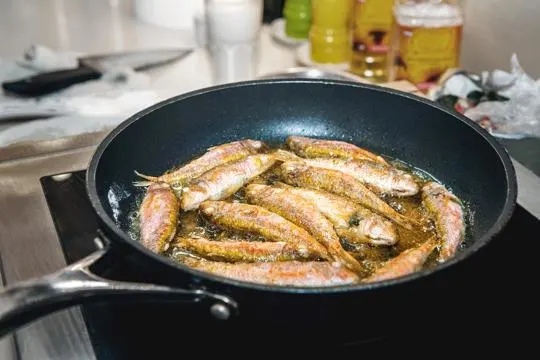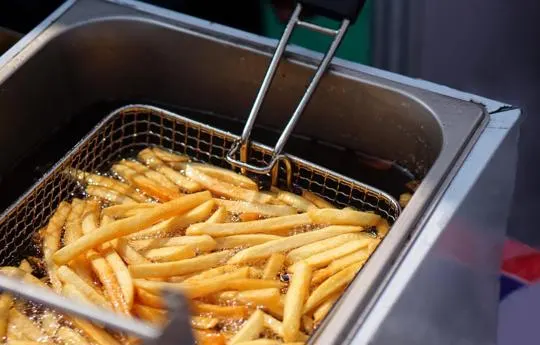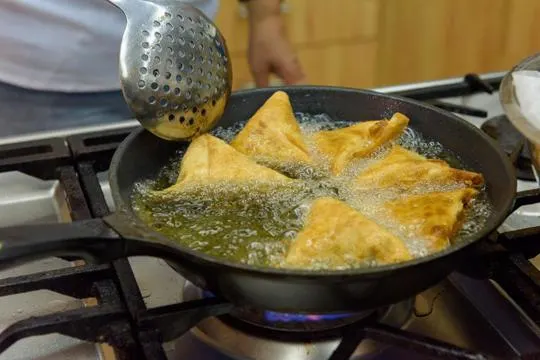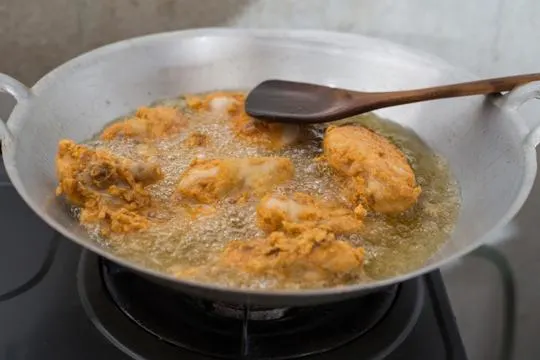Summary of key points
The main difference between shallow fry and deep fry lies in the amount of oil used. Shallow frying involves cooking food in a small amount of oil, usually just enough to cover the bottom of the pan. Deep frying, on the other hand, requires submerging food completely in hot oil.
Deep frying tends to result in a more crispy exterior due to the higher temperature and longer cooking time, while shallow frying leaves the food with a lighter coating of oil. However, both methods can be used for a variety of dishes and add delicious flavor and texture to foods.
When it comes to health considerations, shallow frying may be a slightly healthier option as it uses less oil. However, moderation is key when indulging in deep-fried foods.
In the kitchen, we all have our battles. Shallow fry vs deep fry stands out. It’s not just oil and heat. It’s about crunch vs. crisp, and how we like our exteriors.
Deep frying dunks food completely in oil, ensuring a uniform coat of golden perfection. It’s the secret behind your favorite fries. Shallow fry, on the other hand, lets one side chat with the oil at a time. It’s a dance, flipping stuff in the skillet.
We’ve burnt things. Admit it, so have you. Each method has its champions and moments. Steak? Shallow. Doughnuts? Deep.
This isn’t rocket science; it’s tastier.
What is Shallow Frying?

Shallow frying is a cooking technique that uses a small amount of oil or fat.
This is unlike deep frying which requires more oil and the food is totally submerged.
This method produces a crispy outer layer and a tender inside.
To get it right, the oil should be hot. Not too hot though, or it will burn or become greasy.
To give the food a golden brown crust, coat it in breadcrumbs or flour before adding it to the pan.
Shallow frying is quicker than deep frying as there is less oil to heat.
It also uses less oil making it healthier.
However, it may not be suitable for food that needs to be cooked for long, as it won’t cook evenly.
What is Deep Frying?

Deep frying is a way of cooking food in hot oil or fat.
It results in an outer layer that’s crispy and golden-brown, while the inside stays moist.
Commonly used for foods like french fries, chicken wings, and donuts.
The food is put into hot oil. This creates a Maillard reaction, giving the food its crispiness and flavor.
There’s also steam generation, keeping the food moist.
Various types of oils and fats can be used for deep frying.
Canola or peanut oil are popular due to their high smoke points, meaning they reach high temperatures without burning.
Neutral flavored oils are preferred so they don’t overpower the taste of the food.
Deep frying is a great way to get crispy and flavorful results.
But, eating too much of it can have health effects due to its high calorie content and potential for producing harmful compounds when heated.
Differences Between Shallow Frying and Deep Frying

Shallow frying and deep frying may appear the same but differ vastly.
Oil Depth and Amount
Shallow frying and deep frying require different depths and amounts of oil.
This impacts the outcome of the dish. Shallow frying requires a thin layer of oil in the pan.
It is great for cooking things like pancakes or eggs.
This method keeps the dish light and less greasy.
Deep frying, however, needs enough oil to submerge the food.
This method produces a crispy exterior and a tender inside.
But, it also makes the food more greasy.
Knowing the difference between shallow and deep frying helps you pick which is best for your desired outcome – light and less greasy or crunchy and indulgent.
Cooking Technique
Shallow frying and deep frying are two differing cooking techniques.
Shallow frying utilizes a small amount of oil, usually in a frying pan or skillet.
This creates a crunchy coating on the food, while keeping it tender inside.
Deep frying is when food is entirely submerged in hot oil.
It cooks quickly and produces a crunchy, evenly browned texture.
A key difference between these methods is the amount of oil used.
Shallow frying uses less, making it a healthier option.
Deep frying, however, creates scrumptious foods like French fries, chicken wings, and doughnuts.
Cooking time also differs. Shallow frying takes longer as the food must be flipped.
Deep frying cooks faster due to the hotter oil. Flavor-wise, both methods have their pros.
Shallow frying lets you taste more of the food’s natural flavor, since it takes up less oil.
Deep-fried foods have a unique flavor that comes from the hot oil.
Texture and Crispiness
Shallow frying yields a texture that is delicate and slightly crisp.
Whereas, deep frying produces a crunchy and crispy exterior.
Shallow-fried foods have a subtle crispiness, allowing the true flavor of the ingredients to come through.
On the other hand, when deep-fried, the outer layer gets incredibly crispy whilst trapping moisture inside.
Additionally, shallow frying uses less oil, resulting in a softer texture, whereas deep frying immerses the food completely in oil for extra crispiness.
Moreover, shallow-fried dishes tend to keep their shape better than deep-fried foods.
This is because shallow frying requires flipping the food midway through cooking, providing an even browning on both sides.
To sum up, shallow frying offers a delicate and slightly crisp texture with retained shapes, while deep frying yields an intense crunchiness throughout.
Ultimately, it is up to your individual preference which one you prefer.
Health Implications
Shallow frying and deep frying have vastly different health implications.
Shallow frying requires less oil, leading to lower calories and being seen as healthier.
However, deep frying increases fat absorption and can cause cardiovascular diseases.
When selecting a cooking method, these factors should be considered.
Shallow frying requires only enough oil to cover the pan.
This uses less oil and lower caloric intake compared to deep frying.
Plus, it can give food a crispy texture while still keeping its natural flavor.
Shallow frying is usually viewed as more healthy due to the lower fat content.
Deep frying is when food is completely submerged in hot oil, making it crisp and golden.
Though this seals in moisture, it also allows food to absorb more oil.
This causes higher fat content and caloric intake compared to shallow frying.
It can also cause obesity, heart issues, and other health problems.
Plus, deep frying can create compounds like acrylamide, which links to cancer.
This is formed from starchy food cooked at high temperatures.
Shallow frying at lower temps can help reduce the amount of these compounds.
To be healthier, it’s best to opt for shallow frying over deep frying.
Limiting the consumption of deep-fried food can help decrease calories and potential health risks.
Moderation is key with any fried food.
By understanding shallow and deep frying’s implications, individuals can make informed decisions about their diet and health.
Similarities Between Shallow Frying and Deep Frying

Shallow frying and deep frying share some things in common.
Both use hot oil to make a crispy and tasty dish.
The oil should completely cover the food for even cooking and a golden brown color.
Attention is needed to avoid overcooking or burning.
The process for both is similar.
Start by coating or breading the food.
The coating seals in moisture and keeps out the oil.
Also, both require the right temperature to get the desired texture and doneness.
Moreover, both provide a quick way to make crispy food on the outside and tender inside.
The biggest difference is the amount of oil needed.
Shallow frying uses less oil, ideal for smaller portions or when conserving oil.
Deep frying involves more oil for larger items like a whole chicken or French fries.
Factors to Consider When Choosing Between Shallow Frying and Deep Frying
It’s crucial to think about a few things when selecting between shallow-frying or deep-frying food.
These considerations include the type of food you’re cooking, the texture and taste desired, and health implications.
- The food type is an important factor. Shallow-frying is perfect for delicate items such as fish fillets and chicken cutlets. This allows for even cooking. Deep-frying is best for foods that need a crunchy outside, like french fries and fried chicken.
- Texture and taste must be taken into account. Shallow-frying tends to be less greasy with less oil absorption, giving a crisper finish. Deep-frying has a richer flavor due to the amount of oil used.
Health should also be considered.
Shallow-frying usually requires less oil, making it healthier.
Foods also retain more nutrients since they spend less time in hot oil.
Type of Food
Confusion often arises regarding shallow frying and deep frying.
Both involve immersing food in hot oil, but the technique and outcome are different.
Shallow frying uses less oil and food is partially submerged.
It is flipped to cook both sides, leaving a crispy exterior with retained moisture.
Deep frying requires more oil and food is completely submerged.
High heat seals the exterior and cooking is thorough.
This method produces a crispy texture with characteristic flavors.
Shallow frying is used for delicate foods, whereas deep frying is preferred for items needing a crispy texture.
By understanding the differences between shallow and deep frying, we can make informed choices when preparing our favorite dishes.
Cooking Equipment
Cooking equipment is key when it comes to getting the perfect dish.
It’s essential to differentiate between shallow fry and deep fry.
Shallow fry requires a flat-bottomed pan or skillet.
This distributes the heat evenly, ensuring food is cooked on both sides.
Deep fry needs a specialized deep fryer or deep pot filled with oil.
This ensures the food is totally submerged in hot oil.
The cooking processes for shallow fry and deep fry are different too.
Shallow frying uses a small amount of oil, enough to cover just half of the food.
This creates a crisp exterior and retains moisture.
In deep frying, the food is totally submerged in hot oil.
This locks in moisture and flavors, for a golden crispiness.
Temperature control also matters.
For shallow fry, medium-high heat works best.
Deep fry requires a constant high temperature of 350-375°F (175-190°C).
This ensures the perfect crispness without absorbing excess oil.
Desired Result
Shallow frying and deep frying are two cooking methods with distinct results.
Shallow frying uses a small amount of oil, so only the bottom part of the food is submerged.
Deep frying has the food fully immersed in hot oil.
This leads to different textures and flavors.
For shallow frying, the limited oil exposes the bottom of the food directly to heat.
This creates a golden, crispy outside and keeps moisture inside.
The result is usually lighter and milder.
When deep frying, the food is completely in hot oil.
This makes the exterior crunchy and crispy from moisture evaporating.
It also gives the food a rich, intense flavor and absorbs more oil.
Deep frying needs higher temperatures to seal the outer layers and stop too much oil being absorbed.
Shallow frying uses lower temperatures to cook through without burning or drying out.
Choosing which method depends on what the cook wants.
Shallow frying is good for delicate ingredients that need to stay moist.
Deep-frying is perfect for a crispier texture, like French fries or chicken wings.
In conclusion, shallow frying and deep frying bring different characteristics to dishes.
Knowing their differences helps cooks pick the best method for their desired outcome – whether it be light and moist, or a crispier delight.
Conclusion
It’s clear that shallow frying and deep frying have different outcomes for all types of food.
Each method has its own benefits and drawbacks, and it is essential for cooks to understand which approach to take when preparing food.
Whether you’re looking for a crunchy exterior or a crispy shell, shallow frying or deep frying will prove valuable depending on the recipe.
Just remember that because of the need to use large amounts of oil or other fats, it is best to consume foods cooked using either method in moderation.
At the end of the day, it’s all about trying out different techniques, finding out what works best for you, and experimenting with new ingredients.

Leave a comment